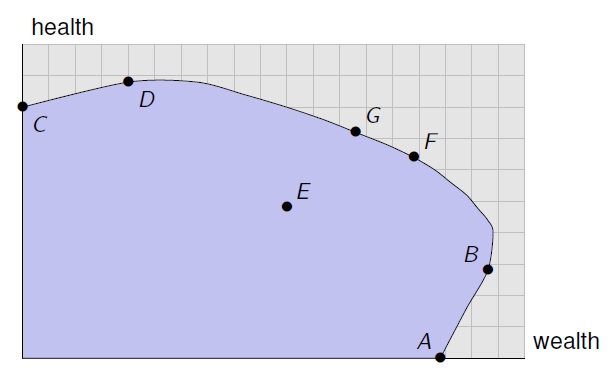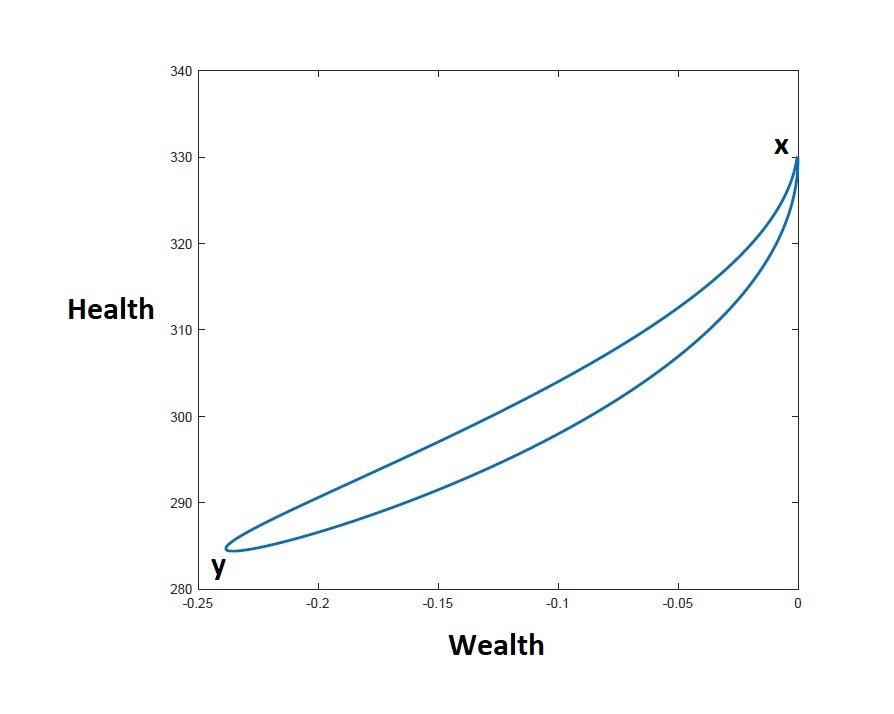
The health-wealth tradeoff of lockdowns is still hotly debated. Here are some thoughts that may help untangle the issues. 1/17 #EconTwitter #EpiTwitter
Figure courtesy of @luismbcabral
Figure courtesy of @luismbcabral

Let's start with concept of tradeoffs. With aggregate societal wealth and health on the axes, we can show all combinations that we can achieve though different policies. All points in purple region are feasible, those outside it are not. Which point should we choose? 2/17
Since society values both health and wealth, from any starting point, we want to move in North-East direction. When making a move, we say that there is a tradeoff if gaining more health necessarily means giving up some wealth. 3/17
It can never be optimal to stay at an interior point like E, because we can get both more wealth AND more health by moving to points like G or F on the frontier. So at an interior point like E, there may be no tradeoffs at all. We can find policies to improve BOTH. 4/17
At extremes with 100% or 0% lockdown (like points A and C or nearby points), we're on frontier but again may be able to get both richer and healthier. But in intermediate cases, like G and F, there is necessarily a tradeoff. 5/17
To get more wealth, say move from G to F, we need to move along frontier and give up some health. So in this region, there is a health-wealth tradeoff. What does this mean and is it useful for choosing which policy to pursue? I don't think so and this is why. 6/17
First, in practice we are very unlikely to be on the frontier, but rather at an interior point like E. So rather than obsess about the slope of the frontier (which is negative when there are tradeoffs), we should try to get to the frontier. 7/17
Second, even if we were on the frontier and thus facing tradeoffs, it tells us nothing about optimal policy to trade off health and wealth over time. Disease and economy have complicated intertwined dynamics so the optimal policy across epidemic is very complicated. 8/17
To get to a point "in the middle" of the health-wealth frontier does not mean we need a policy that treats health and wealth "equally" at each point in time. How much we must suppress the disease depends on where we are in the epidemic. And so it changes over time. 9/17
Consider simple SIR epidemic model with costly social distancing measures. The plot shows path of per-period health costs versus mitigation costs over time of an optimal policy that maximizes overall social welfare. Plot idea by @t0nyyates 10/17 

We start at point like x in pre-infection world, with no expenditures on restricting disease spread and no health impacts of infection. If epidemic does not occur, we stay at x forever. But as infection sets in, health outcomes deteriorate and mitigation costs are incurred. 11/17
We see this by following lower part of curve that takes us to point y. Note that this movement involves both higher economic harm and worse health outcomes. As infection rises, causing morbidity and mortality, so do necessary economic damage to control disease. 12/17
Once point y is reached at peak of epidemic, things improve and we move back to starting point x. This involves decreasing infection levels and less damage caused by economic restrictions. Note that inbound path has higher wealth for any level of health than outbound path. 13/17
This means that it's optimal to impose tighter restrictions before the peak than after the peak, all else equal. One can think of the additional economic harm at the early stages as an investment in better future health and economic outcomes. 14/17
In summary: (1) there may be tradeoffs when economic and public health policies have already taken us to the frontier. Short of this, expect it to be possible to improve both health and wealth somewhat. 15/17
(2) even if we know which frontier point we want to reach, it tells us little about good policy. Health-wealth frontier is static concept; controlling disease and economy is intrinsically dynamic in nature. Optimal path has tricky intertemporal and intra-temporal tradeoffs. 16/17
The analysis of the frontier is taken from @luismbcabral's excellent new textbook that is freely available at luiscabral.net/economics/book… Please share! 17/17
• • •
Missing some Tweet in this thread? You can try to
force a refresh


